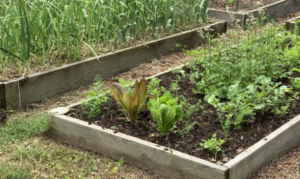Many beginning gardeners plan to grow their vegetables in raised beds — and for good reason! Those of us who have been raised bed gardening for years testify to how much we enjoy it! Better harvests, less weeding, sharp aesthetics — what’s not to love?
But as in any venture, there are mistakes to be made. The problem with making mistakes in a raised bed garden is they aren’t easily corrected. I know this first-hand!
From my own experience and from hearing the experiences of others, I’ve compiled these seven mistakes raised bed gardeners commonly make.
If you’re planning a raised bed garden for the first time or adding to your existing beds, this will help you avoid many of the mistakes I and others have made. And if you’re already gardening in raised beds but are seeing lackluster results, you may find some reasons why here.
1. Raised Beds are too wide.
One of the biggest benefits of raised bed gardening is avoiding soil compaction. You want to be able to work in your garden beds without stepping on them. This promotes a better soil structure and ultimately healthier plants.
But if the width of your raised beds prevents you from working all sides within your reach, you will find yourself stepping inside the bed, defeating this major purpose of a raised bed.
For this reason, raised beds should never be more than four feet wide. Most people can comfortably reach into the center of a four-foot-wide raised bed without any problem. But as I’ve experimented with different sizes, I’ve found a three-foot-wide span is even more comfortable for me.
When choosing the width of your raised beds, you also must consider the placement of the bed. If you situate your raised beds next to a fence, I recommend the width not to exceed thirty inches. This way, you can work your bed from one side only with ease.
2. You don’t plan for irrigation.
Unless you want to hand-water your raised beds with a watering can (and that will get old quick), you need to plan ahead of time how you will irrigate the beds.
First, I recommend placing raised beds near a water source. Whether you plant to hand-water your beds or use a more efficient system of soaker hoses or drip lines, having water easily accessible will save you much time and headache.
In my early years of gardening, I placed a lawn sprinkler near my raised beds to overhead water my garden. But this proved entirely inefficient. Not only did overhead watering waste water, but it also exacerbated many of the fungal diseases common in my area like early blight and powdery mildew.
Now I recommend soaker hoses or drip irrigation for raised beds. For just a few raised beds, soaker hoses will perform just fine.
But if you have more than a few raised beds, or if you garden with a combination of raised beds and ground beds like I do, setting up a drip irrigation system works great and costs less.
3. Material Used is Unsafe.
Though you will find a myriad of speculation about the safety of certain pressure-treated wood for use in raised beds, most experts agree on this: do not use pressure-treated wood manufactured prior to 2003.
Pressure-treated wood manufactured prior to 2003 contains chromated copper arsenate, and you don’t want that near your food garden. Modern methods of pressure-treated wood use safer practices, and whether you choose to use it is a personal decision.
Many people choose to use rot-resistant and chemical-free woods such as cedar or redwood, but prepare to pay more if you go that route.
If you’re looking for cheap raised garden beds, you might want to repurpose wood that was used in a different capacity. Perhaps you have an old fence you are taking down, for example. To be safe, just make sure it wasn’t manufactured prior to 2003.
What other materials can you use for raised beds? Many people are starting to build beds out of steel panels. With any new idea for raised bed materials, do your research first. Avoid old railway ties (which contain harmful creosote), for example, and do your research before you use old tires.
4. Raised Bed Garden Soil Lacks Nutrients.
Many soil combinations will work well with raised beds, but some do not. Potting soil, for example, drains too quickly. Unless your raised bed sits on concrete or rocks (and thus acts more like a container), skip the potting soil. You need more substance than what potting soil can provide.
Another mistake well-intentioned gardeners make is using soil with too much nitrogen content, like a bed full of composted manure or a bag of soil filled with chemical fertilizers. Your plants will grow great but fruit-producing plants like tomatoes produce little fruit.
Another caution: I have found that plants grown in a raised bed filled only with bagged soil grew much slower than those beds with some amount of organic material mixed in.
The best success in raised beds is using a combination of native soil (or garden soil) and organic material like compost, but depending on what you have available and your budget, you have many options to choose from. The possible combinations of raised bed soil can get overwhelming, especially if you’re on a budget.
5. Raised Beds are placed too close together.
Working in raised beds can be the joy of any gardener. That’s why you want to create the most comfortable working area as possible.
To do this, you want enough room to be able to work between the beds comfortably — two to three feet at least. I made this mistake by only allowing about a foot between my raised beds, and it’s always a challenge weeding, planting, and harvesting from those edges.
When you place your raised beds, ensure you can get your garden cart or wheelbarrow in between them. When you have enough space to do that, you can sit a stool beside the beds for a comfortable working area.
6. Pathways grow up with weeds and grass.
There are few things more frustrating than going out to my garden, planning to enjoy some time working in my raised beds, and discovering the grass has grown up beside them.
If you don’t want to keep mowing or weed eating the grass and weeds around your raised beds, place a barrier down before the weeds and grass emerge for the season.
Broken down cardboard boxes with a light layer of mulch on top works great! But an even easier method I’ve begun to use is rolling brown kraft paper between beside my beds and covering with mulch.
I do recommend organic mulches. Skip the landscape fabric because weeds will eventually get through anyway. Pine needles are my favorite for pathways because they break down more slowly than other materials.
7. Neglecting to Mulch Raised Beds.
Mulching your raised beds is just an important as mulching in a ground garden bed, and perhaps even more so.
Though weed pressure is usually less in raised beds, it isn’t non-existent. Weed seeds from native soil find light and sprout. Seeds floating in the wind and deposited from birds love the rich soil of raised beds. For these reasons, mulch will dramatically reduce your weeding time.
But more importantly, mulch regulates the soil temperature and retains moisture — both critical needs of raised beds in the hot summer.
One huge advantage of raised beds is how the soil heats up quicker in the spring, allowing for faster planting. But it also heats up as the season goes on. Mulch helps regulate that temperature more than bare soil would.
Mulch also regulates moisture. In wet seasons, it acts like a sponge, absorbing excess rainfall. In dry times, it keeps moisture from evaporating in the heat of the summer. You will find your mulched raised beds much healthier than those without it.
Hopefully, by avoiding these mistakes, you will be on your way to an enjoyable raised bed gardening experience with abundant harvests!




